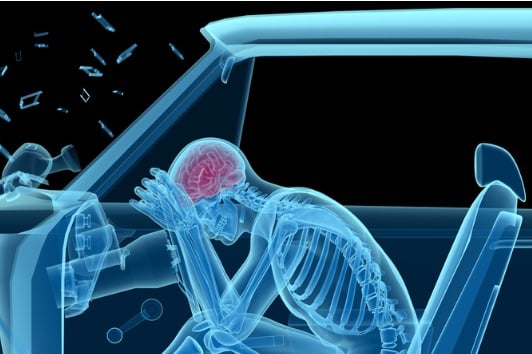Whiplash
Understanding the Symptoms, Causes & Treatments for Whiplash
Understanding Whiplash
Whiplash is an injury to the soft tissues of the neck caused by forced flexion followed by hyperextension of the neck. Muscles, tendons, and ligaments that surround the bones of the neck are stretched beyond their limits in whiplash injuries. This type of sudden stretching often results in pain. In rare instances, whiplash injuries can lead to cervical disc herniations if the person had previously degenerative changes in their neck. These injuries are often caused by motor vehicle accidents, sports injuries, or falling from a height. Symptoms often subside after a few weeks of recovery and non-surgical management.


Symptoms of Whiplash
People with whiplash may have neck pain, stiffness, and tightness radiating from the head out into the shoulders and upper back. Additional symptoms may include headaches, muscle spasms, tightness or knots. Whiplash can range from mild to severe. However, most people with whiplash usually recover completely within a few weeks. If your pain is not getting better after a few weeks seeking further evaluation with a spinal specialist is recommended. Additional work-up including advanced images or prescription medication and therapies may be warranted to improve your symptoms.
When to Seek Treatment for Whiplash
If you’re noticing symptoms associated with Whiplash and suspect a spinal issue, it’s crucial to consider consulting a board-certified spinal specialist. Reach out promptly to a certified spine surgeon for an accurate diagnosis and timely treatment. Early intervention can significantly improve your overall well-being and provide a broader range of treatment options, which may decrease as symptoms persist. The key to a successful and speedy recovery lies in addressing the root of the pain with your spine specialist as soon as symptoms arise.
While many people experience day-to-day back or neck pain, dismissing it as soreness, this may not be the case for everyone. If your pain persists for more than 10 days, it should be taken more seriously. Evaluate such prolonged pain with a spine surgeon to identify the root issue and determine the appropriate treatment. Additionally, be attentive to other signs related to back or neck pain that should not be ignored, including pain accompanied by fever, pain associated with loss of bladder control, and weakness/tingling/numbness in your arms or legs.
It’s important to note that these are general guidelines based on our expertise in spine care over the past three decades, recognizing that each patient’s symptoms may be unique.


Common Causes of Whiplash
Whiplash is typically caused by injuries associated with motor vehicle accidents, sports injuries, or falling from a height.
The mechanism of whiplash most commonly involves uncontrolled forced flexion followed by hyperextension of the neck. The term whiplash refers to the symptoms caused by damage to the surrounding structures in the neck including bones, discs, ligaments, nerves, and muscles. The neck has 7 bones called vertebral bodies stacked on top of one another. In between those bones are the intervertebral discs that act as the shock absorber of the spine. Ligaments connect bones to other bones to provide structural support. There is a bundle of nerves called the spinal cord that is housed in the middle of the spinal column which branches out to the rest of the body. Muscles in the neck provide stability and motion.
Diagnosing Whiplash
A whiplash injury involves the soft tissue structures of the neck and not normally the bones. However, imaging is important especially if the whiplash injury is due to a high velocity car accident in which case often trauma x-rays of you lying down are taken. During your initial evaluation at the Virginia Spine Institute a detailed medical history is taken and a comprehensive physical exam is done. We may also do standing x-rays of your neck for further evaluation.


Treatment Options for Whiplash
Most of the time whiplash does not lead to long-term neck problems and people with whiplash do not usually have trouble with degenerative changes or arthritis in their neck once they are healed. In the short term, medications are commonly used to calm down inflammation, reduce muscle spasms and control pain. A soft neck collar may be used for comfort. Spine-specialized physical therapy is helpful to reduce muscular spasms and restore range of motion. Modalities may include manual massage, dry needling, stretching, and strengthening to aid in the recovery process as well. Symptoms often subside after 2-3 weeks of rest, activity modification, and the above remedies. Regenerative Medicine can also play a role in treatment. If you experience prolonged pain related to whiplash it is imperative to have a spinal specialist examine your condition, and assess the most effective treatment to decrease pain and restore function.

